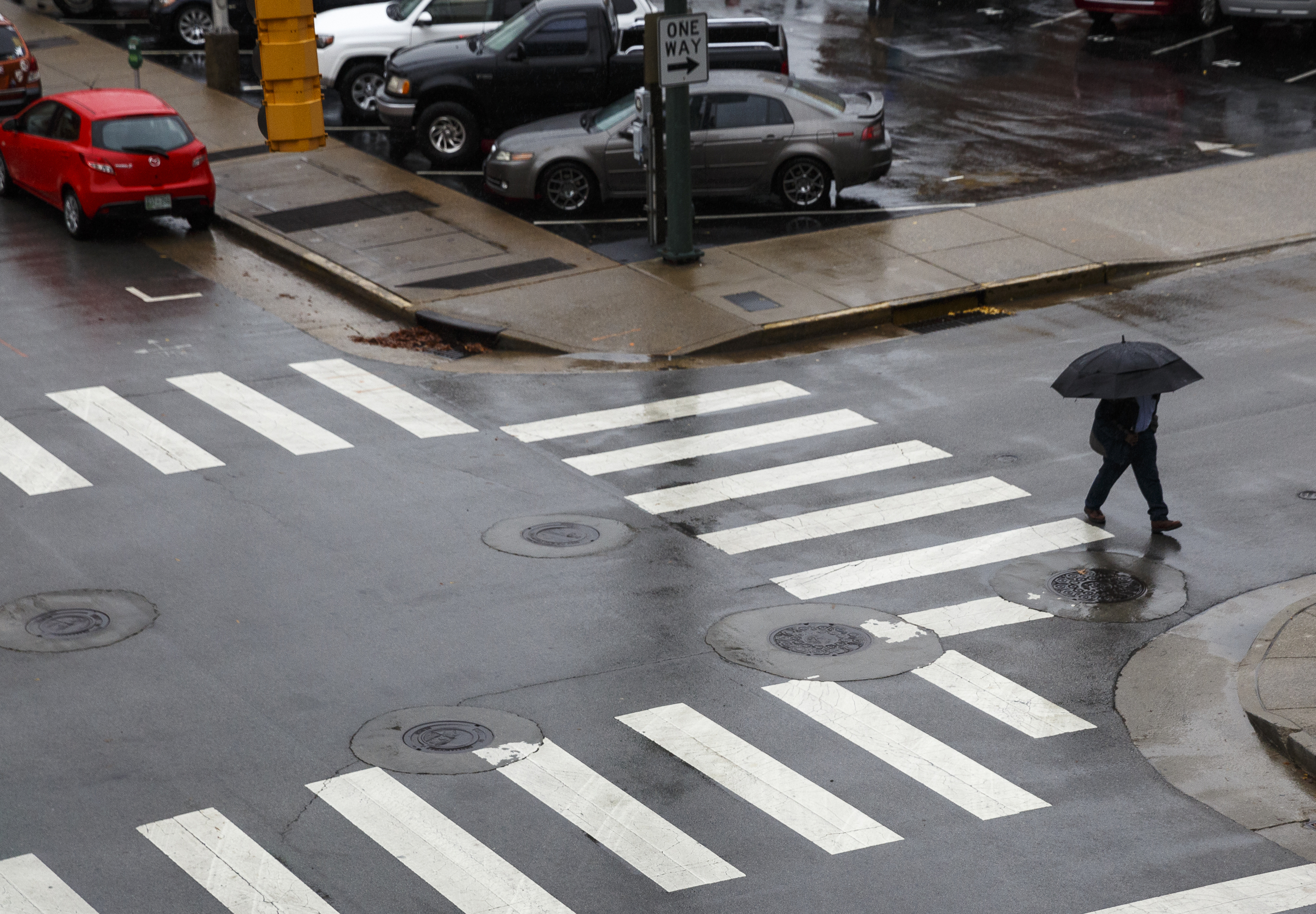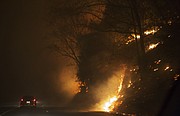Steady rain early this week squashed the chance of 2016 becoming the driest year in the city's modern history, but it hasn't ended a 51-county burn ban in Tennessee.
The regional ban remains in effect throughout the eastern half of the state until Dec. 15, despite 1.37 inches of rain Sunday, 0.43 inches Monday and another considerable dose Tuesday in Chattanooga.
"We want to make absolutely sure that conditions are completely safe before the ban is lifted," said Jim Dale, Tennessee assistant district forester.
 A pedestrian walks in morning rain at the intersection of Chestnut Street and 7th Street on Tuesday, Dec. 6, 2016, in Chattanooga. Despite recent days of rain, the region remains in a severe deficit of rainfall for the year.
A pedestrian walks in morning rain at the intersection of Chestnut Street and 7th Street on Tuesday, Dec. 6, 2016, in Chattanooga. Despite recent days of rain, the region remains in a severe deficit of rainfall for the year.
By the numbers
1904: Chattanooga's driest year on record with 32.68 inches of rain 1994: City's rainiest year on record with 73.7 inches 52.48: Annual rainfall average in inches 32.26: This year's total rainfall as of Monday
Devastating Gatlinburg fires
- Emergency management officials warn of Sevier County fire recovery scams
- President Obama signs disaster declaration to aid Sevier County
- Gatlinburg firefighting team may head home soon [videos]
- 2016 wildfire season one for the books; officials say it's too soon to say it's over [video]
- Governor seeks quick action on disaster request for Tennessee [photos]
- Did Sevier County's lax building codes help fire spread?
- Chapel of Love lost to fire that ravaged Gatlinburg
- Card games raise cash for fire victims
- Teens charged in fatal Gatlinburg wildfire were playing with matches
- Tourists stream back to Gatlinburg, but rebuilding looms
- Two juveniles arrested, charged in deadly Gatlinburg wildfires
- Businesses that survived the Gatlinburg wildfire are reopening
- Gatlinburg wildfires death toll climbs to 14; officials estimate 1,684 structures damaged or destroyed
- Officials defend controversial timing of evacuation warnings sent after blaze reached Gatlinburg [videos]
- Cars line up to see wildfire-ravaged Tennessee city; 13 dead
- During first look at wildfire rubble, residents in a daze
- Haslam heading to wildfire-ravaged Gatlinburg today
- Death toll from Tennessee wildfires increases to 13
- Search continues for any survivors of wildfires
- Dollywood Foundation to donate $1,000 per month to fire victims
- More than 70 area firefighters helped fight massive fires in Gatlinburg
- University of Tennessee professor predicted Gatlinburg fire for years
- Chattanooga firefighters drive 150 miles to answer Gatlinburg's call for aid as blaze rages
- Dolly Parton heartbroken by wildfires torching her hometown
- Deadly, destructive wildfires ravage Tennessee tourism town
- Tennessee mayor confirms 3 deaths in wildfires
- Wildfires scorch tourist area in Tennessee; thousands flee
- Video: Two men navigate horrifying Gatlinburg mountain fire
- Rhea County students safe after wildfires force evacuation
- Chattanooga firefighters drive 150 miles to answer Gatlinburg's call for aid as blaze rages
- The Latest: Officials say thousands evacuated, 4 injured
- Gatlinburg aquarium workers worried about animals left behind after wildfire forces evacuation
- Gatlinburg, Tenn., hotels, homes destroyed in fires
- Wildfires lead to evacuation of downtown Gatlinburg, Tenn.
More than 50 wildfires were active in Tennessee in mid-November. By Tuesday, that number had dwindled to five, including three in Hamilton County. Those three fires - Flippers Bend, Poe Road and Mowbray Mountain - were 98-100 percent contained Tuesday morning.
Dale said a fire can be fully contained with a line established around it and still be considered active because of underground burning.
"We've had lots of fire burning underground," he said. "With the amount of rainfall we have not had, it takes quite a bit of rainfall to put that out."
The driest year on record for Chattanooga is 1904, when the city received 32.68 inches of precipitation. This year's total had crept to 32.26 inches by Monday afternoon. The annual average is 52.48 inches and the record is 73.7 inches, set in 1994, according to the National Weather Service.
On Nov. 27, the day before Gatlinburg's wildfire disaster, Dale told the Times Free Press his one concern about the looming rain in the region was the wind forecast to precede it. And in Sevier County, his feared was realized.
As of Tuesday, the death toll from the Smoky Mountain wildfire fanned by those winds remained at 14 people. A total of 145 people have been treated for fire-related injuries or illnesses, and 1,753 homes and businesses were damaged or destroyed.
"I think fully that if we had the wind velocities, or even half the wind velocities, that the folks over in Gatlinburg saw, then we would have had a lot more trouble than what we did with those three fires in Hamilton County," he said. "We would have had all kinds of trouble. You shudder to think about it, but with wind-driven fires like that, you're always thinking about structures, and it's just a frightening thing."
Periodic rain and normal humidity levels over the coming months will be key to helping end the drought and preventing more wildfires, Dale said.
Low temperatures can freeze dry leaves and other fuels, and low humidity can suck the moisture away from dampened fuels.
Alabama Gov. Robert Bentley on Monday ended a statewide "no burn" order that had been in effect since early November.
"In recent days, we have seen significant rainfall across our state and the Alabama Forestry Commission now believes the worst of the drought has ended," Bentley said in a statement.
Partial burning restrictions remain in place for numerous North Georgia counties. The Georgia Forestry Commission maintains a breakdown of bans on its website, gatrees.org.
Illegal burning in the Tennessee counties still under the ban is punishable as a Class A misdemeanor, which carries a fine of $2,500 and/or up to 11 months and 29 days in jail.
Generally, the burn ban does not apply to cooking grills established in a confined, protected area away from woodlands, according to the Tennessee Forestry Commission.
Contact staff writer David Cobb at dcobb@timesfreepress.com or 423-757-6249.
Wildfires ravage Southeast
- Two juveniles arrested, charged in deadly Gatlinburg wildfires
- Tennessee takes four area counties off burn ban list to aid tornado cleanup
- Rain helps with area wildfires, but Tennessee burn ban remains [videos, photos]
- Gatlinburg wildfires death toll climbs to 14; officials estimate 1,684 structures damaged or destroyed
- Nonprofits and state agencies step up relief efforts amid tornado, wildfire damage
- Man charged for allegedly intentionally setting a Sequatchie County wildfire
- Rain brings relief for wildfires
- Southern storms should ease drought, but fire threat remains
- At long last, substantial rain is expected throughout Chattanooga area
- Gov. Bill Haslam applauds wildfire fighters' efforts
- Firefighters make progress in Southeast wildfires, but threat remains
- Crews fighting large fire in northeast Alabama
- Gov. Haslam vows to pursue wildfire arsonists 'with everything we have'
- Hamilton County wildfires to cost more than $600,000
- Forestry crews prepared to miss Thanksgiving with families as they battle wildfires
- Wildfires rage on; new one pops up in North Georgia
- Gasp! Wildfires cause hacking and wheezing across the South
- Air quality improves, rain possible this weekend
- Relentless smoke spreads fear at edge of southern wildfires
- Catoosa County issues burn ban
- Many outdoor activities banned as fires burn across south
- Two men charged with arson as crews make progress quelling 3 area blazes
- Chattanooga is on target to break record for driest year in city's history
- Alabama man confesses to starting Sequatchie County fire
- Area wildfires containment increases, Flipper Bend fire 95 percent contained
- Catholic Mass offered for wildfire relief
- Fire crews hope to reach 100 percent containment on 3 area wildfires
- Wildfire smoke engulfs Chattanooga, endangering health of residents
- No rain in forecast as Chattanooga area wildfires continue to burn
- Tennessee Gov. Haslam issues 51-county burning ban
- Firefighters use hand tools to fight Chattanooga-area wildfires with no rain in sight
- Hundreds hospitalized with breathing problems amid Chattanooga-area wildfire outbreak
- Sohn: Might wildfire smoke be harbinger of days to come?
- New fires sprout in Chattanooga area as firefighters work to contain thousands of acres burning across region
- Arson suspected in most Chattanooga area wildfires
- UPDATE: Man arrested after admitting he set three wildfires that consumed 300 acres
- The latest update on the unprecedented fire season in the tri-state area
- Wildfires burning total of 9,680 acres across eastern half of Tennessee; FEMA steps in to offer aid [videos, photo galleries]
- Southern fires rage with 41.6 million now living in drought
- Wildfires continue across region with no rain imminent; some residents evacuated
- Chattanooga area wildfire smoke triggers 'Code Red' air quality alert [videos]



